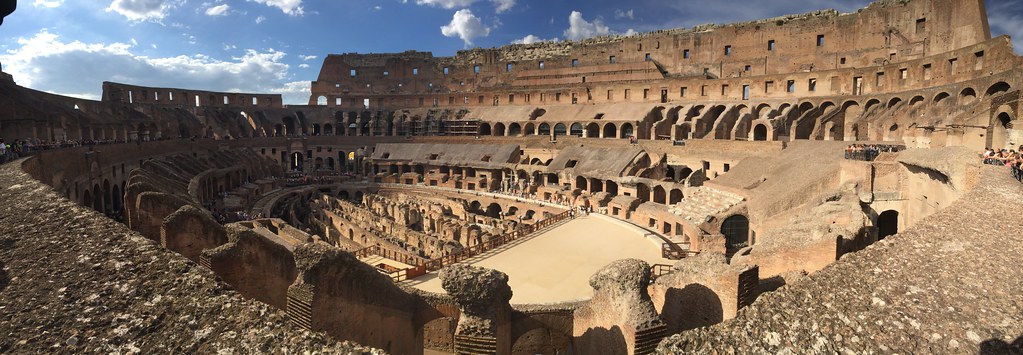 |
| A panorama of the Colosseum. [Photo: Serene] |
It couldn't been any later than 7:30am when we were gathered in the 'lobby' (aka bus stop) at the bottom of the flight of stairs of Casa Dane. Our train back to Rome was scheduled to depart at 8:18am. No time was lost as the whole group trooped over to CB Mos, the little station cafe to exchange our breakfast vouchers for one croissant and one coffee, the standard issue for the past few days whenever we were on the run.
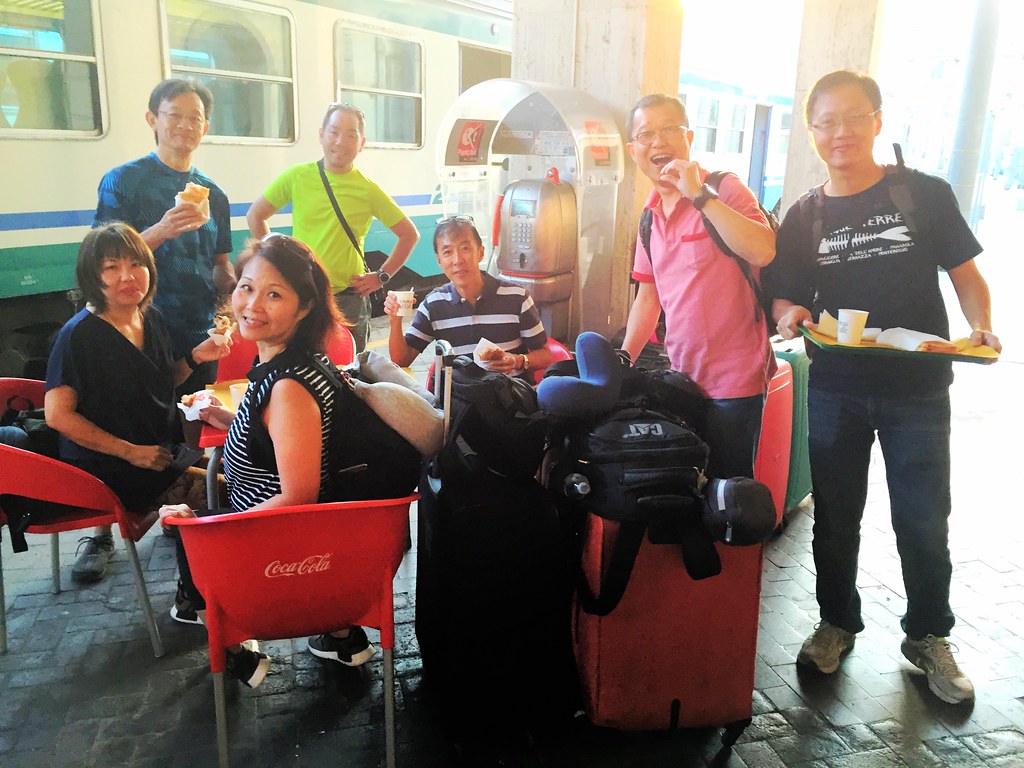 |
| Exchanged our breakfast coupon at CB Mos for croissant and kopi. |
Table of Content:
- Day 1 - To Rome
- Day 2 - Historical Roma
- Day 3 - Of Medieval village & Italian wine
- Day 4 - The tour of Tuscany
- Day 5 - The Magic of Cinque Terre
- Day 6 - The Magnficent colours of Ligurian Italy
- Day 7 - Back to the Home of Gladiators
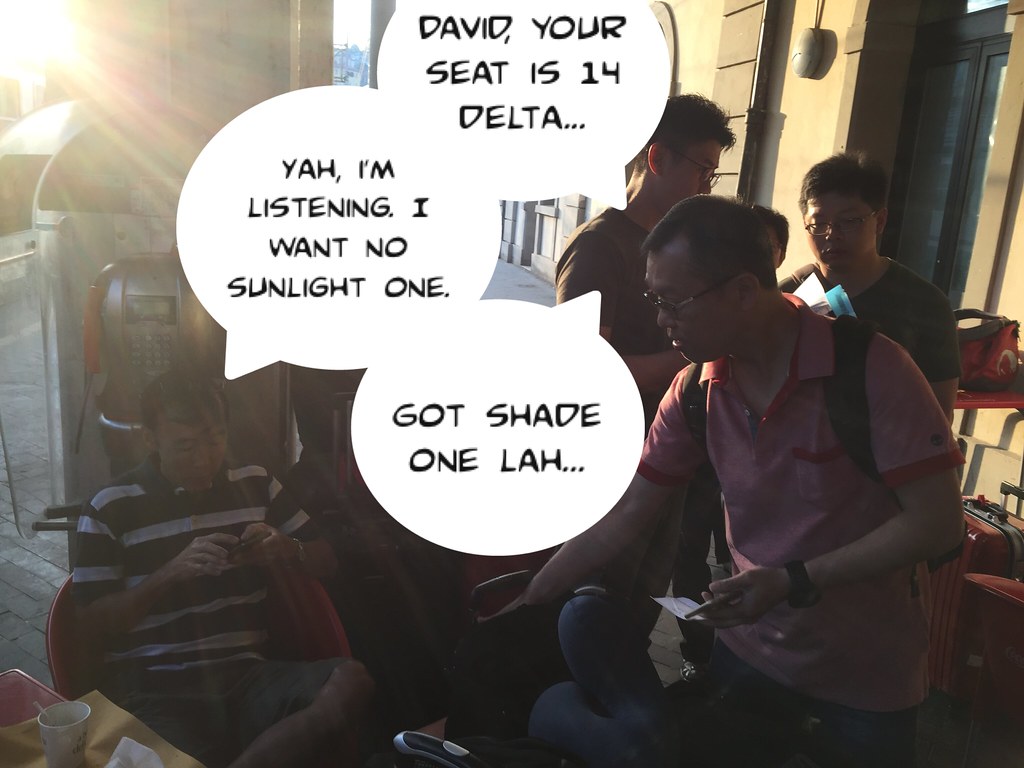 |
| Breakfast at CB Mos at the La Spezia train station. |
We were luckier this time round, as Adrian managed to arrange for three Mercedes Benz vans to pick us up from Roma Termini back to San Giusto hotel, the good 'ol old hotel with another few flights of stairs to carry our luggage up (gladly and happily we all did that, knowing that this was the SgTrekker tradition that must never be broken).
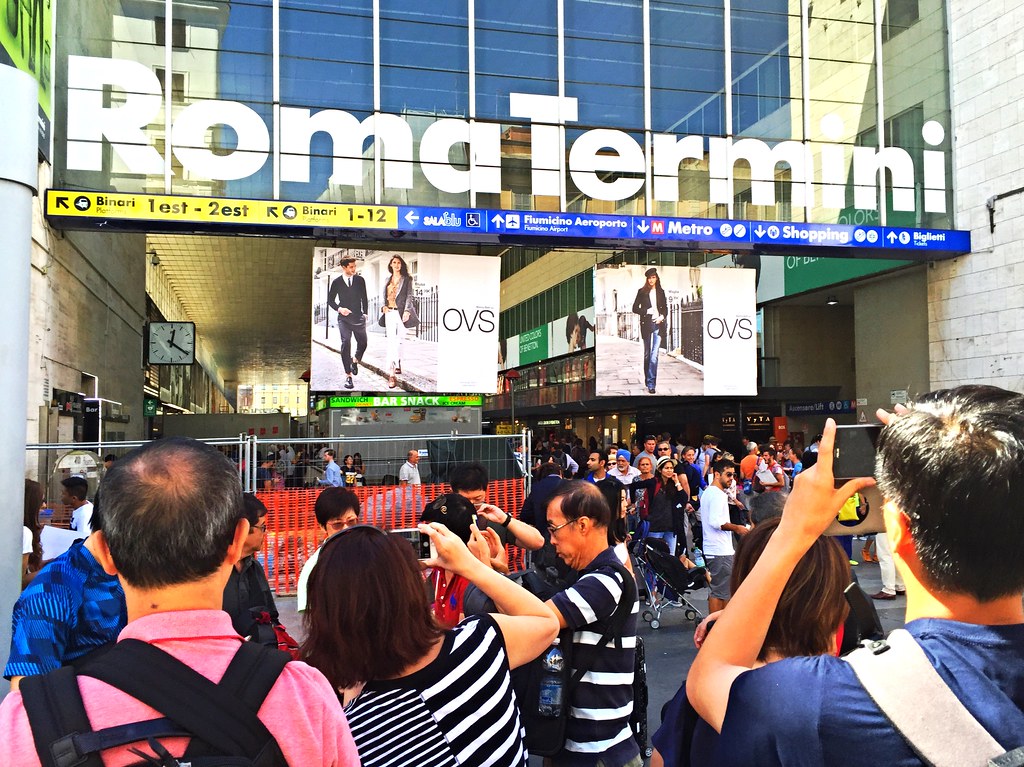 |
| "Be CAREFUL of pickpockets at the Roma Termini!" warned people. |
San Giusto was really a good 'ol hotel with good 'ol carpets that added a sense of majesty as well as a whole aerial assault of molds and dust mites that came naturally with good 'ol beds and good 'ol carpets that hadn't exactly been well maintained by good 'ol staffs of the hotel. I thought I was the only one who suffered from the allergies, but after asking around the next day evening, I realised that I was the norm, rather than the exception.
Another observation that I made, and after consultation with several others confirmed my suspicion, was that the free wifi in the hotels of Italy really really CMI. The download and upload speeds were such that they were best left for browsing text-based web sites. Even the better hotels such as San Giorgio and Casa Dane's wifi were slow, leaving us to conclude that it was a nation-wide malady. Thus Alex was glad he bought the 50Gb WIN prepaid SIM card right on day one, and Kai Sing and Serene happy to have acquired their 10Gb TIM prepaid SIM card for €28 (about S$42) and myself and Lai Peng could not be more satisfied with our Data Passport from M1, which allowed us to make use of our local data bundle (mine was a 13Gb bundle) for one month in Italy for S$25.
"Ok, for most of us who are going to be doing that optional €42 per person guided tour of the Colosseum, we will meet at the lobby. For Lai Peng and Joanne who are going to shop at the boutiques, please go ahead and enjoy and meet us for dinnr at 7:30pm," announced Adrian.
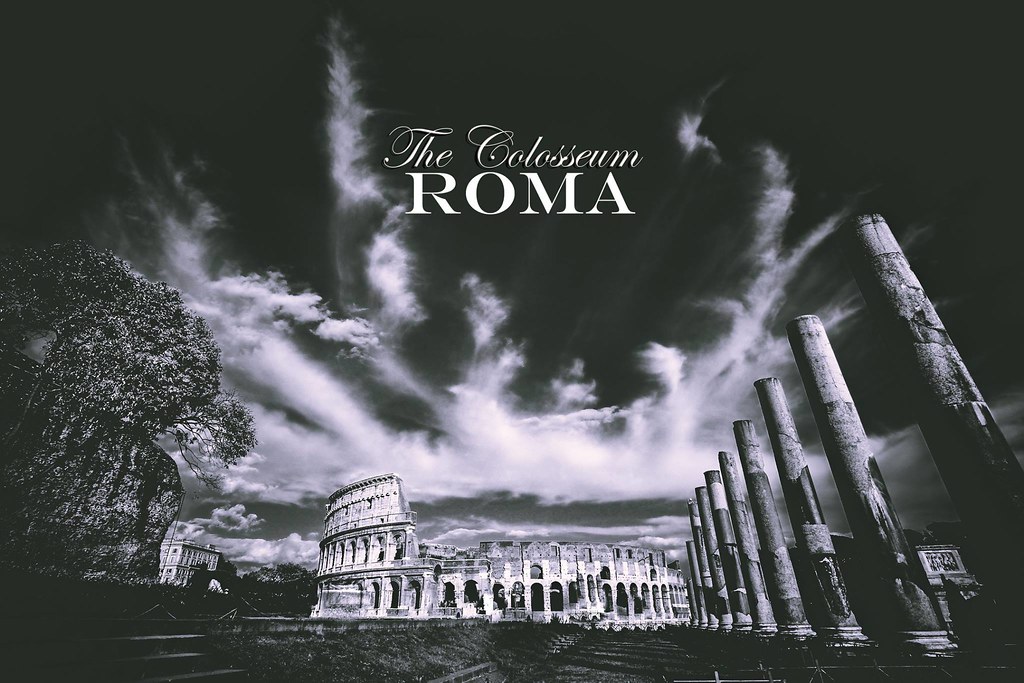 |
| The Colosseum. [Photo: Eddy] |
The tour of the Colossuem, the Palatino and the Forum.
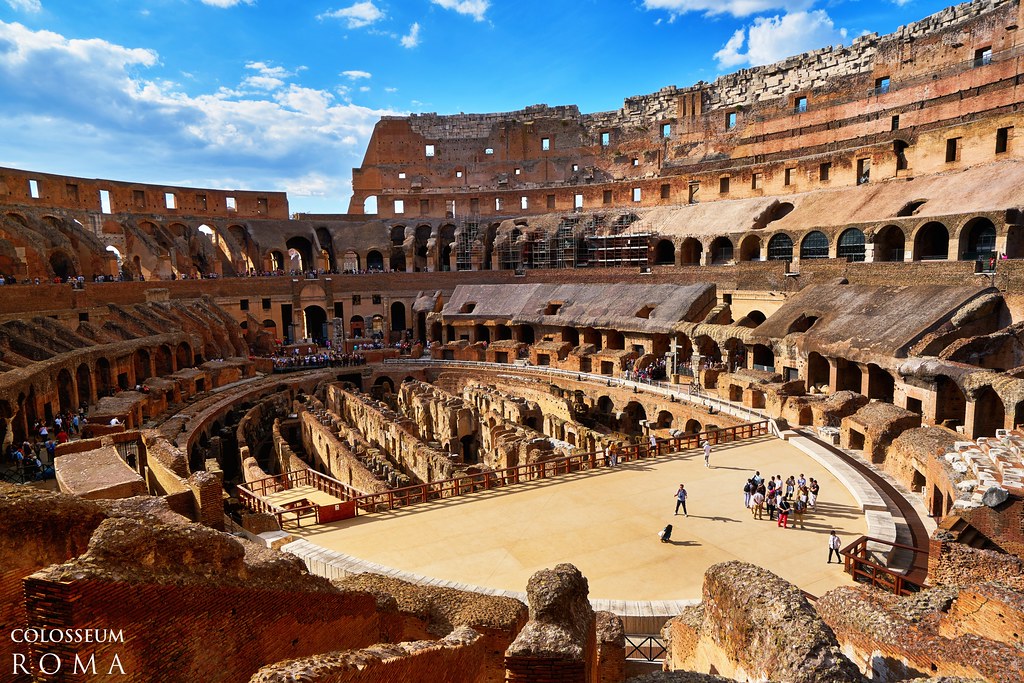 |
| The interior of the Colosseum showing the underground levels below the platform. [Photo: Alex] |
At around 3:30pm we were delighted to meet up with our guide Vito again at the Colosseum, a short metro train ride from Bologna station to Colosseo station. I really liked Vito because he was a knowledgeable guide with a great sense of humour, very Italian in nature. And he was forever patient, even with a group of slow-moving tourists like us who would almost always spend more time than allocated taking photos and selfies. I was torn between following him and listening to his explanation and staying behind to take shots.
It was the first time I beheld this colossal structure from such proximity, after so many movies and shows I had watched over my life time of ancient Roman times. Like many other visitors out of Italy who were ignorant of Roman histories, my only association with the Colosseum was Gladiators.
I knew this tour was going to be an exceptional one with Vito at the helm, leading us through the heart of the giant.
The security at the rear gate was very strict and we had to have our water bottles emptied and tripods bagged and every single one was instructed separately not to use the tripod in the colosseum.
Vito wasted no time and started speaking even as we walked towards the rear entrance, pointing out to our team members who were in the construction industries some of the unique architecture and construction.
 |
| Illustration map from Wikipedia of Central Rome during the Roman Empire with the Colosseum on the upper right. |
Building completed in 80AD, after a decade of construction, the Colosseum was unveiled by the Roman Emperor Titus. It had a seating capacity of more than 50,000 and was the site of gladiatorial contest. Most of the gladiators were slaves and prisoners of war. The way the seats were occupied during those days was by way of allocation for the royalty and the wealthy, and for the common people, by simply squeezing as many as possible to the sections for the lower people. So the capacity could often elevate to significantly more than the designated 50,000.
Indeed it was surprising to me. I hadn't expected the ground to be like this, half-thinking that we will be seeing a sand-covered floor within the arena of the closseum. What met the eyes was a dug-out exhibiting basements one and two.
Vito continued to explain that the entry of the gladiators was through trap doors that opened through the floor of the arena. This, he said, would be so much more exciting for the spectators. And this had to be rehearsed again and again prior to the actual day of the fight. The Editor of the whole fight would be the one who planned the whole show. During those days, the whole day would be dedicated to fighting and it would be an affair from morning till evening. That was why there was a huge awning called the Velarium on the top of the Colosseum that covered the elite spectators from the noon sun. More importantly those wealthy patrons and the royalties would be seated on the south side of the arena where the midday sun would not shine upon.
He went on to point out the marble seats on the lower rows where family names of the wealthy were etched out. These were the seasoned ticket seats. And while the commoners would need to jostle for spaces, those from the high societies would saunter in any time to take their family seats permanently reserved.
"When the colosseum crumbled and went into disuse, the people stole the iron from the bolts in the pillar because iron was expensive. But the weight of the stones kept the structure intact, even though the iron bolts were no longer there," explained Vito.
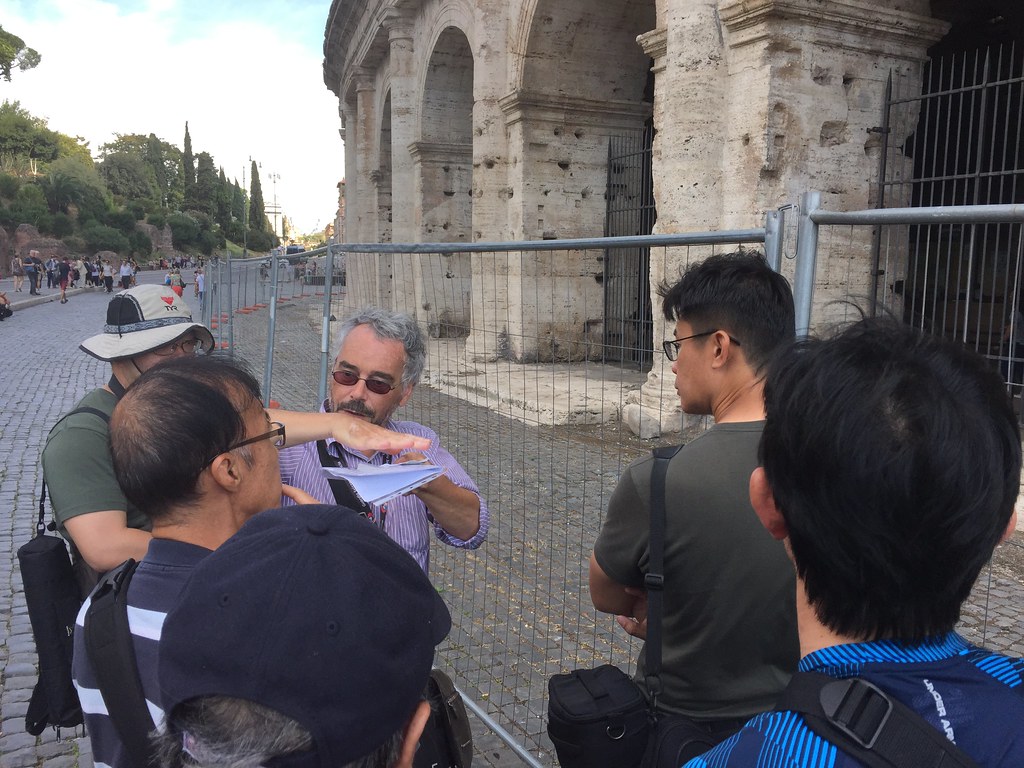 |
| Explaining how the iron bolts were pilfered. |
"That's why when you look at the pillars, they look like cheese with all the holes inside them," continued Vito.
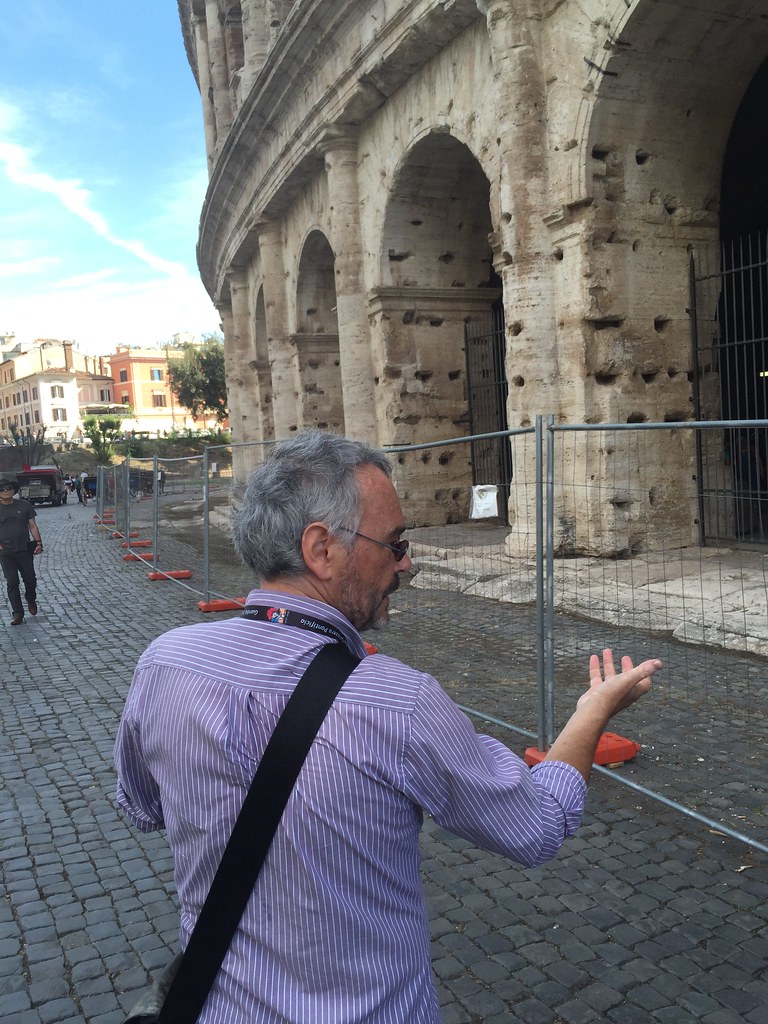 |
| "The cheese". |
"With the original ground removed, what you see here is the basement two layers," explained Vito.
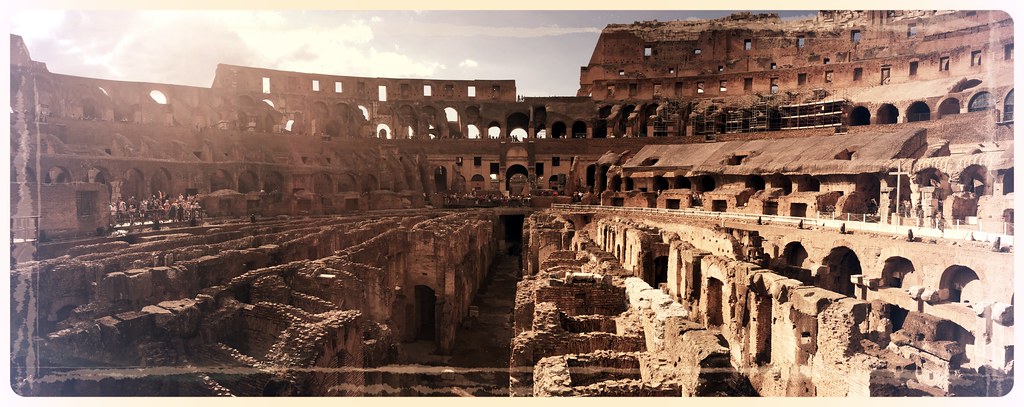 |
| A panorama of the interior of the Colosseum by Serene. |
Indeed it was surprising to me. I hadn't expected the ground to be like this, half-thinking that we will be seeing a sand-covered floor within the arena of the closseum. What met the eyes was a dug-out exhibiting basements one and two.
"Basement one is where the gladiators rested and prepared. Basement two is where the supporting servants and slaves worked."As far as my memory served me, I remembered that when I watched the gladiators movies, the warriors would come out from the heavy iron gates on the side of the arena, and when the beasts were released they were also done so from the big heavy gates. So that was my impression of the arena.
"So Vito, where are the side gates where we always see the gladiators come out from in all the movies?" I asked.He laughingly pointed to the two major tall and heavy iron gates on opposite sides of each other. But they were not for that spectacular entry we saw in the shows. One was the 'Gate of living' for the surviving gladiators to walk out triumphant; and the other one was the 'Gate of the dead' through where the guards would drag the dead bodies out, blood and intestines all spilling.
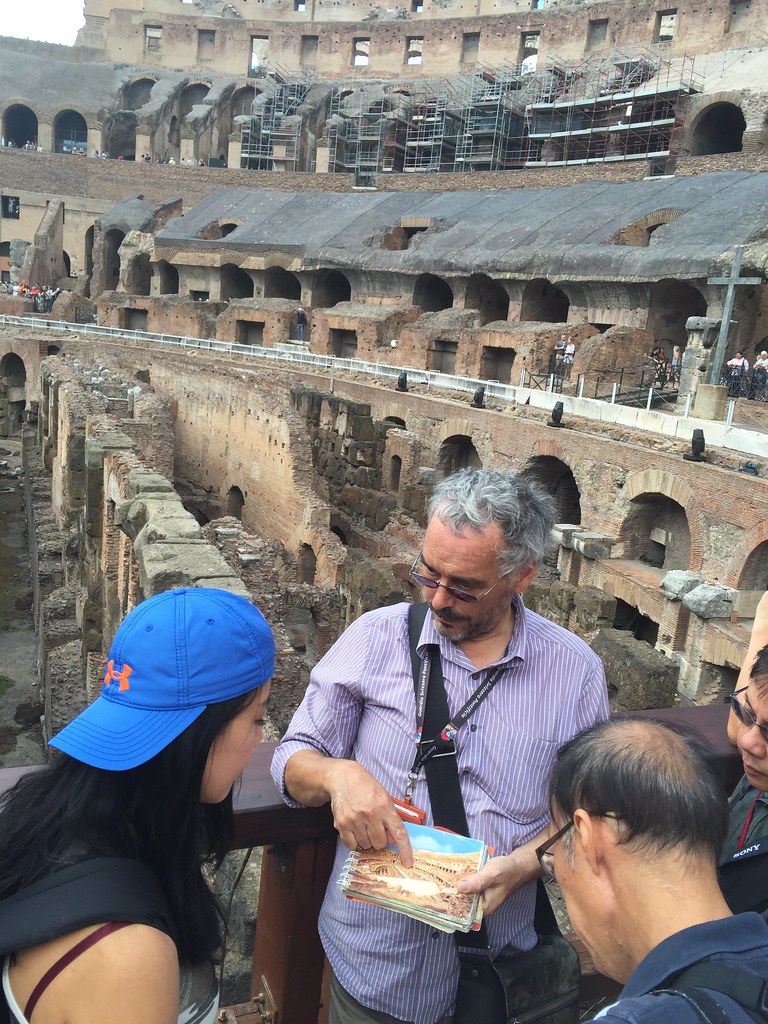 |
| Vito showing how it looked when the basements were all covered up. |
He went on to point out the marble seats on the lower rows where family names of the wealthy were etched out. These were the seasoned ticket seats. And while the commoners would need to jostle for spaces, those from the high societies would saunter in any time to take their family seats permanently reserved.
"Look at those walls. You see the different sections, the brick wall connected with the stones and then the brick walls again? This was a piece of genius engineering," Vito directed our attentions towards the corridors. "They did this so that if there was diagonal crack through any section, it would stop at the interface and not crack all the way down to the foundation, thus protecting the building."
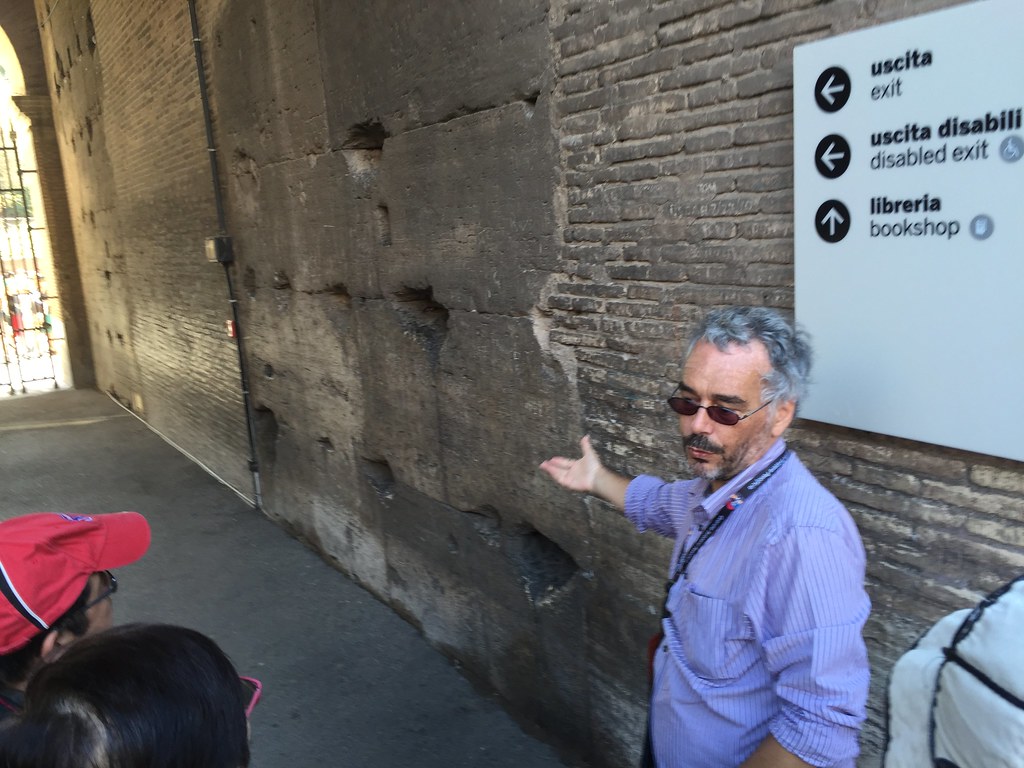 |
| Vito proudly showing how his ancestors cleverly interfaced the walls. |
This Colosseum was such an eyeful. Everywhere I turned my head, my senses were overloaded. There wasn't a pause button which I could press to stop the playback so that I could slowly piece by piece appreciate the stones and marvels and arches. It was getting very crowded with visitors steaming in from every orifice of the giant.
Our boys and girls were so busy trying to grab as many shots from as many angles as possible, while we were being subtly pulled by Vito in front and pushed by the oncoming crowd from behind.
"The last time I was here, I did an evening tour and they brought us to the basements in the eerie darkness of the night. It was quite scary," shared Lai Peng about her previous visit to the Colosseum. That would have been quite an experience. But for me, perhaps the next time.
"Wow look at the marble floor," I pointed out to David.
"Yah, they are so worn out that they are smoothened. It will be so slippery," replied our glass specialist.
"Yeah, man. I can imagine when it rained, how many spectators wearing Roman sandals must have slipped and fallen down the stone steps here," I thought out loud.
Round and round we walked, passing through archways in and out of the corridors onto the lane between the seat sections. Quickly, Vito pointed to us the entrance to the section for the Royal family. And as quickly we descended the steep tall stone steps back to the hounded level. In my mind I was telling myself what long legs the Romans must have had to walk with ease up and down these tall steps.
The Palatino (Palace)
We were guided up another gran, wide pavement outside of the colosseum up to the hill where the ruins of the old Palace stood.
We needed to rush to enter the grounds of the Palatino before the guards closed the place at 5pm. As we queued up at the turnstile, the x ray machines in front picked up a penknife in the bag of a British lady who was pleading with the guards to let her bring it in, delaying everyone behind her.
Now that we were out of the Colosseum and the hoardes of visitors and finally into the palatial ground, Vito heaved a sigh of relief and slowed down his pace to leisurely guide us through the intricacies of the old Palace.
"Here, you can see that the ground levels and the higher floors were occupied by the royal family," he said. "The slaves and servants as well as the guards all stayed down in the basements. Their quarters were all down under, connected by tunnels and underground corridors. Any visitors to the palace would have to be screened by the Royal guards here before allowed entry."
A great part of the Palatino had been destroyed, leaving only a small portion of the ruin still standing, from the wall of the garden we looked out onto a panoramic view of the colosseum to our right and the forum right beneath us and to our left.
Personally I didn't find the old palace one third as interesting as the remains of the building in the Roman forum down below.
The Roman Forum
The sun was drifting lower at the horizon as we approached evening. Walking down the streets of the old Roman forum took us through some of the magnificent ancient temples and buildings. Words could not describe the majesty of these ancient stone structure with their classic Greek pillars. What remained of the forum arches stood silently among the visitors on that sprawling land and the temples were still erect but in deep slumber perhaps still reminiscing old times. My jaw kept dropping as I slowly passed some of the temples:
The Roman Forum
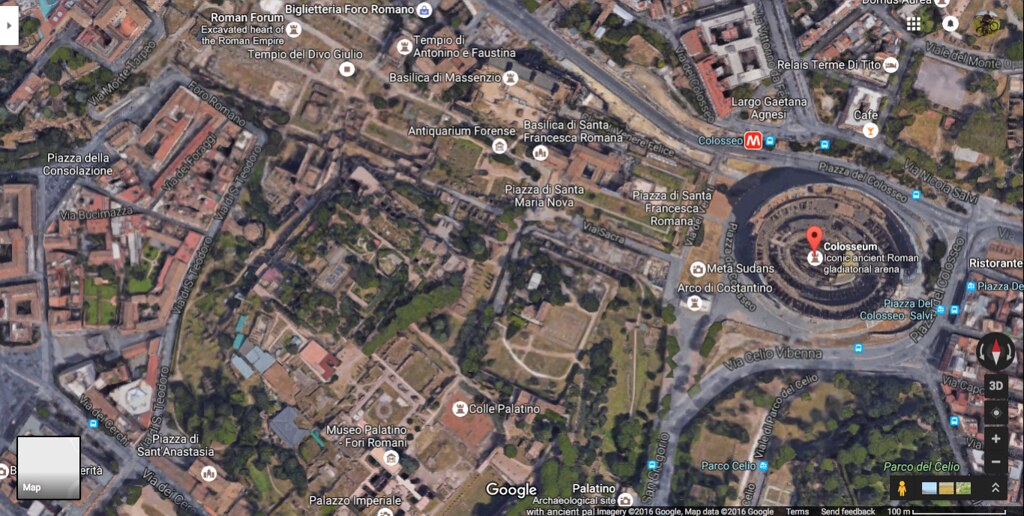 |
| A Google Map showing the relations of the Imperial Palace, The Arco di Constantino, The Temple of Antoninus & Faustina and the Roman Forum to the Colosseum |
- The Temple of Romulus - an understated structure with a dome shaped roof.
- The Temple of Antoninus and Faustina - with its magnificent pillars.
- Ara di Cesare (the Altar of Caesar and his burial ground) - a relatively small foundation left of what used to be a larger temple.
Vito's presentation was fantastic as he had a book named "The Past and Present" in which the pages superimposed upon each other, showing the readers how the buildings and scene used to be in the old days when the transparent layers were laid on.
I took a shot of the temple of Antoninus and Faustina and immediately Telegrammed it over to Ah Li back in Singapore. Her first reply was:
"Look at that history!!!! So nice! I hope five years later it will still be there. Not like Egypt."
We could only have a very perfunctory tour of the rest of the forum, as the time wa fast approaching 6pm and the guards were starting to urge visitors to leave. But we'd seen enough for our first visit. There would, I believe, be a second time and the next round will be with the children.
We bid good bye and parted ways with Vito at the exit. He had been a most wonderful guide, definitely way better than the one in Florence, as he was subtly humourous and was able to answer many of David's challenging questions.
Blue hour shoot of the Colosseum
It was getting late and Adrian was moving us fast through the periphery of the forum, along the main road Via dei Flori Imperiali back towards the Colosseum. In the summer of Italy, the days were longer and sunset usually came close to 7:45pm and blue hour was around 8pm. The Piazza dei Colosseo was inundated. Swarmed with visitors at this evening hours, we found our foregrounds cluttered with bodies of all nationalities. A frown crossed Kai Sing's forehead. Where on earth could he mount his tripod so that he could reduce the number of foreground distraction? Alex's suggestion came to the rescue. With the wifi connectivity of the A7R Mk II, he mounted his tripod high up on the fence and used his iPhone to remotely frame his shot and active the shutter! What marvels of modern technology.
The rest formed a line on the kerb, all lenses pointing towards the Colosseum. With only a 12mm lens, I was the idiot who had to crawl forward to get a closer shot of the amphitheatre.
The rest formed a line on the kerb, all lenses pointing towards the Colosseum. With only a 12mm lens, I was the idiot who had to crawl forward to get a closer shot of the amphitheatre.
"Wei Wee How! Don't get into my frame!" shouted the boys on the kerb. Alamak. 'But in front already got so many people already ah," I protested.
"But your tripod is so distracting!" the guys were right. Tripods were indeed distracting. Jiaklat...
"Wee How, come I show you," the good Adrian to my rescue. "You move to this grass patch on the right side. But don't step beyond the chain onto the grass wait the police will come and catch you." Adrian positioned me swee swee.So there I was, all alone by myself, staring at my ultra-wide shots. Eddy came by and looked through his 10-15mm on his 1.5x crop Sony. He showed me his shots and I was so full of envy. His combination was a real winner.
Then Jeffrey came by and stood beside me for quite a while, shooting with his UWA. These guys were good, for their high-performance cameras with high ISO were really up to the job. My rangefinder could do nothing much below certain light conditions.
The sky darkened and the blueness seeped through. And for only five minutes, the orange hue radiated through the higher stratae of the sky. Gradually the corridor lights of the Colosseum was turned on, their warm light adding on to the effect, and the spot light from outside the Colosseum shone onto the external wall.
Alex kao-beh-ed: "Wah lau, the spot light gave me a patch of bright white on the side of the Colosseum!" Yes, this Alex was a perfectionist. When it came to photographs, no parts of his photos must be burnt. He was very particular about that.
It was later when Michelle saw Eddy's photo and comlained out how the sky on his shots looked so dramatic and had such nice orange light, that Eddy replied: "It was like that mah. The sky was exactly like that, and the orange was exactly like that. The clouds were like that. I didn't do anything. They were just all like that one mah!"Eddy was correct. The clouds, the sky and the orange hue of the setting sun gave the perfect combination of drama and we were fortunate on this evening to have had witnessed it.
"Ok, last few shots. Sao gong lor!" said Eddy. This fellow ah... always so steady. Early early captured his shots and sao-gong already.
8:15pm. A few streets away along Via Claudia was our dinner destination, La Taverna dei 40. Delightful pasta, and everything Italian. The drinks and desserts tasted so good, especially warm when they were sponsored by a caring lead.
"We shot the sunset until so late. Luckily we never ask Joanne and Lai Peng to meet us at the dinner spot at 7:30pm," phewed Alex. The two clever ladies had gone off on their own for more high level acquisitions, their most important planned itinerary of the whole trip.What started out as a simple blue hour shot of the Colosseum in our original itinerary became a much more detail and meaningful tour of the relic with a good brief of the history. It was a €42 well-spent. I loved histories. Especially when there was some expert guide right at the site giving me a live run-through while actually seeing the buildings and artifacts.
By the time we returned to our moldy, sinus-choking, San Giusto hotel with its poor wifi and long climb up the steps, my body clock was already pointing to sleeping time.
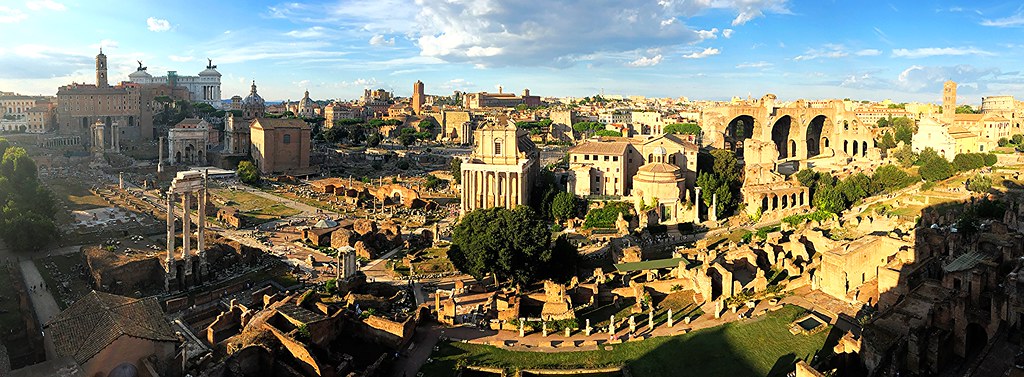
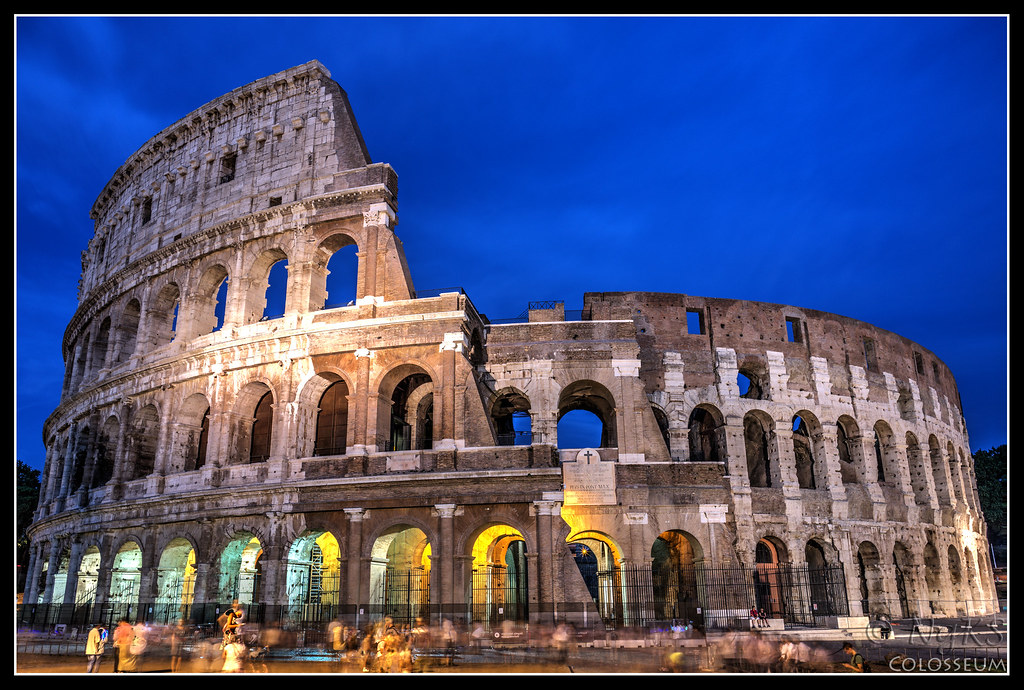
No comments:
Post a Comment